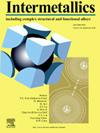Atomic scale insights into super-nano dual-phase amorphous-nanocrystalline iron with synergistic high strength-plasticity
IF 4.8
2区 材料科学
Q2 CHEMISTRY, PHYSICAL
引用次数: 0
Abstract
To reveal the mechanical properties and plastic deformation mechanisms of super-nano dual-phase iron at the atomic scale, molecular dynamics models of amorphous iron (amorphous-Fe), nanocrystalline iron (NC-Fe), super-nano dual-phase amorphous-nanocrystalline iron (SNDP-A/NC-Fe), and super-nano dual-phase nanocrystalline-amorphous iron (SNDP-NC/A-Fe) were established. The results indicate super-nano dual-phase nanostructures have exhibit good strength-plasticity balance. The plasticity of SNDP-A/NC-Fe model exceeds that of amorphous-Fe with higher strength. The strength of SNDP-NC/A-Fe model is higher than that of the NC Fe model with excellent plasticity. The relatively uniform stress distribution leads to the good plasticity of SNDP-A/NC-Fe models owing to the suppression of nanocrystalline on shear band propagation. Additionally, the body-centered cubic (BCC) → face-centered tetragonal (FCT) phase transition lead to the reduction of strength, while the twinning behavior leads to a reduction in plasticity owing to the propagation of mature shear bands. This study has revealed the mechanical properties and plastic deformation mechanisms of body-centered cubic super-nano dual-phase structural materials at the atomic scale, providing a theoretical foundation for the design and application of low-activation steels with high strength and toughness.
具有协同高强塑性的超纳米双相非晶-纳米晶铁的原子尺度研究
为了揭示超纳米双相铁在原子尺度上的力学性能和塑性变形机理,建立了非晶铁(amorph- fe)、纳米晶铁(NC-Fe)、超纳米双相非晶-纳米晶铁(SNDP-A/NC-Fe)和超纳米双相纳米晶-非晶铁(SNDP-NC/A-Fe)的分子动力学模型。结果表明,超纳米双相纳米结构具有良好的强度塑性平衡。SNDP-A/NC-Fe模型的塑性优于非晶铁,具有更高的强度。SNDP-NC/A-Fe模型的强度高于NC -Fe模型,具有良好的塑性。相对均匀的应力分布导致SNDP-A/NC-Fe模型具有良好的塑性,这是由于纳米晶对剪切带传播的抑制。体心立方(BCC)→面心四方(FCT)相变导致强度降低,而孪晶行为由于成熟剪切带的扩展导致塑性降低。本研究揭示了体心立方超纳米双相结构材料在原子尺度上的力学性能和塑性变形机理,为高强韧低活化钢的设计和应用提供了理论基础。
本文章由计算机程序翻译,如有差异,请以英文原文为准。
求助全文
约1分钟内获得全文
求助全文
来源期刊

Intermetallics
工程技术-材料科学:综合
CiteScore
7.80
自引率
9.10%
发文量
291
审稿时长
37 days
期刊介绍:
This journal is a platform for publishing innovative research and overviews for advancing our understanding of the structure, property, and functionality of complex metallic alloys, including intermetallics, metallic glasses, and high entropy alloys.
The journal reports the science and engineering of metallic materials in the following aspects:
Theories and experiments which address the relationship between property and structure in all length scales.
Physical modeling and numerical simulations which provide a comprehensive understanding of experimental observations.
Stimulated methodologies to characterize the structure and chemistry of materials that correlate the properties.
Technological applications resulting from the understanding of property-structure relationship in materials.
Novel and cutting-edge results warranting rapid communication.
The journal also publishes special issues on selected topics and overviews by invitation only.
 求助内容:
求助内容: 应助结果提醒方式:
应助结果提醒方式:


